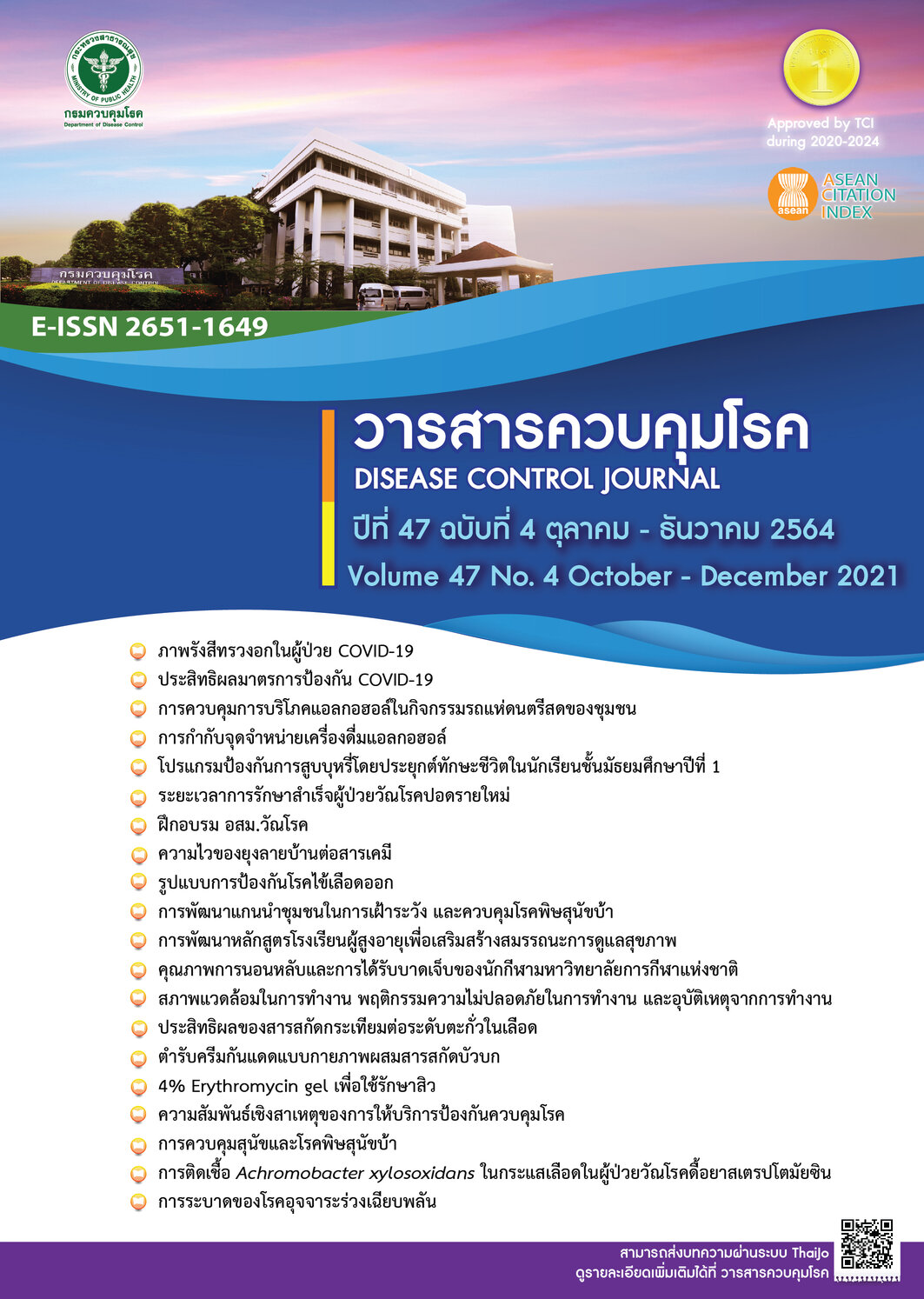Insecticide susceptibility characterization and efficacy of insecticides for thermal space spray application against insecticide-resistant Aedes aegypti (L.) from Chanthaburi Province
DOI:
https://doi.org/10.14456/dcj.2021.84Keywords:
Aedes aegypti, Insecticide resistance, Dengue vector control, Thermal foggingAbstract
The objectives of this study were to investigate insecticide susceptibility of larvae and adults and levels of enzymes associated with insecticide detoxification in adults of Aedes aegypti population from Moo 2, Tambon Patthawi, Amphoe Makham, Chanthaburi Province. Additionally, the efficacy of eight insecticide formulations used for thermal fogging application were evaluated under simulated field conditions against a laboratory insecticide-susceptible strain (NIH) and an insecticide-resistant field population of Ae. aegypti using the World Health Organization (WHO) cage bioassay method. Susceptibility testing using standard WHO methodology, showed Chanthaburi population larvae were highly resistant (13.5% mortality) to temephos (0.012 mg/L). Aedes aegypti female adults were also highly resistant to five synthetic pyrethroids: cyfluthrin 0.15%, deltamethrin 0.05%, cypermethrin 0.05%, lambdacyhalothrin 0.03%, and permethrin 0.25%, with final 24-hr mortality ranging between 0-7.8% and one organophosphate, pirimiphos-methyl 0.21% with 0% mortality. Biochemical assays of Chanthaburi adult Ae. aegypti had increased non-specific esterases and mixed function oxidases (MFO). Significant differences in elevated esterases and MFO activity were found between field population and NIH strain (P<0.001). While there was no significant difference in mean acetylcholinesterase enzymatic activities between field and reference mosqutioes. For indoor space spraying of pyrethroid (7 formulations) and organophosphate (1 formulation) insecticides applied by a handheld thermal fogger at the maximum WHO-recommended dosage, low mortality (0-6.7%) were observed in Chanthaburi population after exposure to each pyrethroid while very high mortality (99.7%) was observed for pirimiphos-methyl (200g/ha), indicating complete susceptibility. Furthermore, the efficacy of pirimiphos-methyl using four serial doses: 20, 50, 75, and 100 g/ha resulted in 13.7, 41.7, 54.8, and 97.7% final mortality, respectively. No significant difference was found in mosquito mortality between pirimiphos-methyl 100 and 200 g/ha (P>0.05). This study indicates that pirimiphos-methyl at an operational dosage of 100g/ha can be considered a viable alternative to control Ae. aegypti, especially in the areas where mosquitoes have developed resistance to pyrethroid insecticides.
Downloads
References
Alejandra MS, Jesus OV. Chemical control of Aedes aegypti: a historical perspective. Rev Costarr Salud Pública. 2013;22:68-75.
Chareonviriyaphap T, Bangs MJ, Suwonkerd W, Kongmee M, Corbel V, Ngoen-Klan R. Review of insecticide resistance and behavioral avoid¬ance of vectors of human diseases in Thailand. Parasites & Vectors. 2013;6(1):280-308.
Sirisopa P, Thanispong K, Chareonviriyaphap T, Juntarajumnong W. Resistance to synthetic pyre¬throids in Aedes aegypti (Diptera: Culicidae) in Thailand. Kasetsart J (Nat Sci.) 2014;48:577- 86.
Amelia-Yap ZH, Chen CD, Sofian-Azirun M, Low VL. Pyrethroid resistance in the dengue vector Aedes aegypti in Southeast Asia: present situation and prospects for management. Para¬sites & Vectors. 2018;11(1):332.
Isabelle D, Veronique T, Pascal G, Jean I, Romuald C, Romain G. Multiple insecticide resistance in Aedes aegypti (Diptera: Culicidae) populations compromises the effectiveness of dengue vector control in French Guiana. Mem Inst Oswaldo Cruz, Rio de Janeiro. 2011;106 (3):346-52.
Suraporn S. Mechanism of insecticide resistance to insect. Prawarun Agr J. 2019;16(1):34-48. (in Thai)
Division of vector borne diseases, Department of disease control, Ministry of public health, THAI-LAND [Internet]. 2020. [cited 2020 Oct 19]. Available from: https://drive.google.com/ drive/folders/1iWq0H64kdUDVwXaB-zQGKzXka281PVdrm
World Health Organization. Monitoring and managing insecticide resistance in Aedes mos¬quito populations Interim guidance for entomol¬ogists. Geneva: World Health Organization; 2016.
World Health Organization. Pesticides and their application for the control of vectors and pests of public health importance. Geneva: World Health Organization; 2006.
World Health Organization. Guidelines for efficacy testing of insecticides for indoor and outdoor ground- applied space spray applica¬tions. Geneva: World Health Organization; 2009.
Abbott WS. A method for computing the effec¬tiveness of an insecticide.1925. J Am Mosq Control Assoc. 1987;3(2):302-3.
Saeung M, Ngoen-Klan R, Thanispong K, Muenworn V, Bangs MJ, Chareonviriyaphap T. Susceptibility of Aedes aegypti and Aedes albopictus (Diptera: Culicidae) to Temephos in Thailand and surrounding countries. J Med Ent. 2020;57(4):1207-20.
Chareonviriyaphap T, Aum-Aung B, Ratana¬tham S. Current insecticide resistance patterns in mosquito vectors in Thailand. Southeast Asian J Trop Med Pub Hlth. 1999;30(1):184-94.
Corbel V, Durot C, Achee NL, Chandre F, Coulibaly MB, David JP, et al. Second WIN In¬ternational Conference on “Integrated approaches and innovative tools for combating insecticide resistance in vectors of arboviruses”, October 2018, Singapore. Parasites & Vectors. 2019;12 (1):331.
Satimai W. The study of using and insecticide resistant in the Eastern Thailand. J Vec-borne Dis. 2010;7:18-30.
Marcombe S, Fustec B, Cattel J, Chonephetsarath S, Thammavong P, Phommavanh N, et al. Dis¬tribution of insecticide resistance and mecha¬nisms involved in the arbovirus vector Aedes aegypti in Laos and implication for vector con¬trol. PLoS Negl Trop Dis. 2019;13(12): e0007852.
Fonseca-González I, Quiñones ML, McAllister J, Brogdon WG. Mixed-function oxidases and esterases associated with cross-resistance between DDT and lambda-cyhalothrin in Anopheles darlingi Root 1926 populations from Colombia. Mem Inst Oswaldo Cruz. 2009;104(1):18-26.
Ping LT, Yatiman R, Gek LPS. Susceptibility of adult field strains of Aedes aegypti and Aedes albopictus in Singapore to pirimiphos-methyl and permethrin. J Am Mosq Control Assoc. 2001 ;17(2):144-6.
Hilary R, Joseph B, Nongkran L, William CB. Insecticide resistance in dengue vectors. TropI¬KA.net [Internet]. 2010. [cited 2020 Oct 19];1:0-0. Available from:
Downloads
Published
How to Cite
Issue
Section
License
Articles published in the Disease Control Journal are considered as academic work, research or analysis of the personal opinion of the authors, not the opinion of the Thailand Department of Disease Control or editorial team. The authors must be responsible for their articles.






